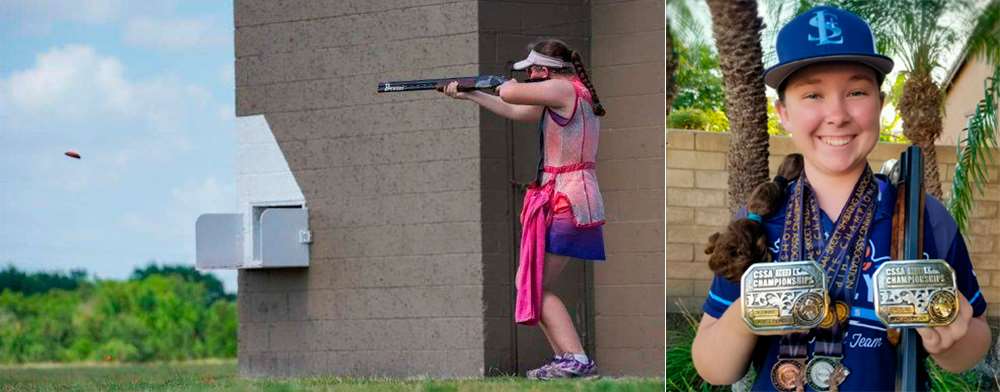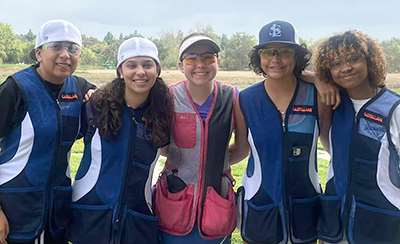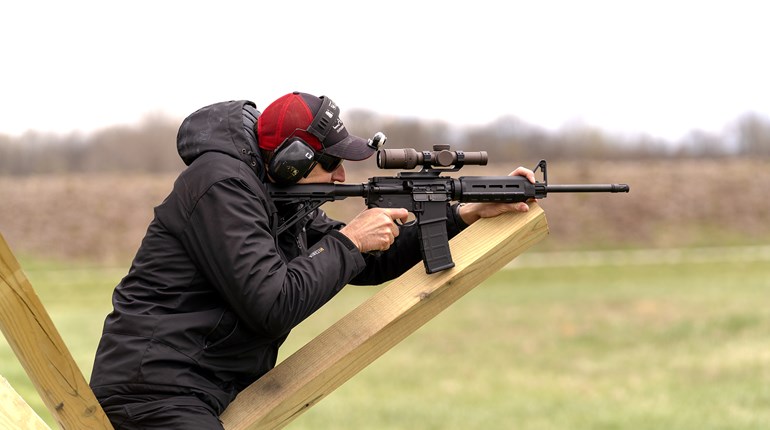
Gun-control proponents are now focused on stopping the next generation from not only learning the truth about their Second Amendment rights, but also how to safely handle firearms and shoot. They want to culturally reshape America into a subservient, disarmed people. To accomplish this, gun-control-supporting politicians and advocates are moving from multiple directions to prevent the young from even having the opportunity to practice their Second Amendment rights.
A recent article in the left-leaning magazine The Atlantic presented one angle of attack on young Americans’ understanding of this critical part of our freedom. The feature, written by Mac Schwerin, was titled “The Ad Industry’s Plan to Fix America’s Gun Crisis.”
“As the public face of firearms, the NRA makes for a compelling enemy,” states the article, which also quotes Tufts University Professor Michael Siegel saying, “Thirty years ago, the tobacco industry was like the NRA.” The article makes this claim to argue that gun owners, and gun manufacturers, should be legally forced to pay for public-service ads produced in straightforward attacks on their own products, just like big tobacco was once forced to do.
“To break new ground, gun-violence-prevention advocates want to reframe the story of guns in America by lifting a page from the anti-smoking playbook,” says The Atlantic article. “In 1998, the four largest cigarette manufacturers signed the Master Settlement Agreement, which was like Big Tobacco’s Treaty of Versailles. It required them to amend their marketing practices and make annual payments to the states to compensate for the medical costs incurred by smoking-related illnesses. Those concessions hobbled profitability—up to a point. But tobacco’s steep cultural decline can be attributed, in part, to a specific provision that allocated millions of dollars to a national PSA campaign aimed at dissuading new smokers.”
The idea here is to force gun makers, and therefore anyone who buys guns or ammunition, to pay for public-service ads to dissuade young people from, say, learning to shoot skeet. To make this argument, they start from the false premise that guns are like tobacco. To make this analogy, this writer appears to be alluding to the often-repeated, but false and debunked, gun-control groups’ allegation that legal gun sales somehow increase murder rates. But this article never spells out this claim—likely because study after study shows that legal gun sales don’t correlate to crime rates, let alone cause them to increase. If gun-ownership rates correlated to crime, we would see some evidence of it. If this were true, wouldn’t a small town in, say, Montana have a higher murder rate than Yonkers?
There are other problems with this gun-control attempt to make gun owners pay for criminal violence; for example, guns are actually used by many Americans to defend life and property, with 1.67 million defensive gun uses per year, according to a recent Georgetown study. How is that like tobacco? Indeed, most new gun owners say they are buying guns for self-defense purposes.
The truth is that learning to shoot, for both youth and adults, is a fundamental, empowering, fun and humbling experience. As with other rights, this right also brings with it a profound responsibility. This, incidentally, is part of the reason why the NRA was founded in 1871: first and foremost, to train citizens to shoot. The NRA has historically helped to train law enforcement, the U.S. military and civilians. It still does. The NRA has been promoted by various government agencies and even by U.S. presidents. It is simply fundamental, that the ability to use modern arms safely and effectively is necessary to keeping individuals and the nation safe.
Nevertheless, this core tenet of the NRA—indeed, of American freedom—is now under direct attack by gun-control groups and the politicians in lockstep with them. The gun-control movement certainly sees its attacks on our constitutional right to keep and bear arms as a long cultural struggle. By making it more difficult for young people to learn to shoot, they know there will one day be fewer adults who own firearms for sport. This will then make it easier for gun-control activists to change the laws by passing more gun restrictions and bans.
“Students, after all, are political innocents” The Atlantic article notes, “they live and die at the mercy of a system they didn’t vote for.”
For many young gun owners, this statement likely rings with decided irony as they watch opportunities they once had, thanks to their hard work and dedication in competitive shooting, destroyed by anti-Second Amendment activists.
“Communications that we had with recruiting colleges, such as Trinity, Hillsdale, Purdue, Jacksonville University and TCU have stopped because they are unable to communicate with youth in California regarding their shooting teams and opportunities,” Jay Fitzgerald posted on social media in July of 2022, as he was frustrated at what California’s then-new law, AB 2571, had on his daughter Lola’s opportunities. “[This is] because of the reasonable fear that if they do advertise, market or otherwise communicate with her (and other minors in California), they will expose themselves to substantial civil liability under AB 2571.”
Lola, who is a four-time Skeet All-American, three-time Junior World Champion and four-time California State Lady Champion in skeet shooting, saw her competitive shooting essentially stopped by the law, all because she is a minor in California.
AB 2571, which bans advertising or marketing firearms or ammunition in a way that is “attractive to minors,” allows for an up to $25,000 fine per violation—numbers most organizations simply can’t risk getting socked with.
“AB 2571 effectively destroys my daughter’s training opportunities to compete at the USA, Olympic and World levels and has shut down her communications with USA and NSSA Shooting and other national groups and recruiters,” said Jay.
Emails from the National Skeet Shooting Association ceased, as did communication from many other organizations, such as USA Shooting.
The Fitzgeralds looked for ways to maintain Lola’s career in the face of the new law, but the barriers became considerable.
“My daughter has also been unable to log into sites to see future tournaments and standings of the shooters as they compete,” said Jay. “All publications have stopped coming to my daughter, and coaches are canceling training clinics that she would usually attend. We are unsure even if we fly our daughter out of state to train whether the coaches would be in violation of the law because our daughter is a resident of California.”
Lola said that, compared to other competitors, being from California definitely puts her at a disadvantage. “Since I am under the age of 18, finding someone who is willing to coach me has been very difficult, since it puts them at risk of getting in trouble. Proper training is very hard to do now since it’s really just me at my home range practicing, so I often have to drill and work twice as hard. Even when I want to go practice, ammo becomes a big concern since it’s so limited in California.”

Lola started the first and only all-girls shotgun shooting team in California. They used to sell raffle tickets for fundraisers at local Bass Pro Shops, raising thousands of dollars for their team. Even with a revision to AB 2571, the girls still aren’t permitted to fundraise on the property, which further limits their ability to succeed.
Some have said that this revision—a September 2022 amendment to AB 2571—“fixed” the law, but ambiguity still haunts California youth shooting.
The changes to AB 2571 make it even more confusing. This has caused many to err on the side of caution—avoiding all contact with shooters who are under 18 years of age. Youth shooting programs are technically allowed, but marketing and communication that may promote any firearm or firearms-related product is not. A coach wearing a branded hat or shirt could be seen as “marketing” to youth. Suggesting equipment is also verboten. Attempting to help a California junior have a better and more-successful shooting experience can put people at significant risk.
Andy Fink, publisher of Junior Shooters Magazine, believes that AB 2571 “is the single worst attack against the shooting sports there has ever been.”
Its effect isn’t limited to California. National champion junior teams have declined to comment for fear of being accused of violating the law. Some ranges have made shooting matches open to those who are 18 and older only—even spectators under 18 have, at times, been barred.
Max Delgarbino, a talented Arizona junior in pursuit of his high-power Distinguished Rifleman’s Badge, had planned to attend a match in California he won in 2021, but his age prevented him, and his under 18 teammates, from going. Bobby Delgarbino, Max’s father, noted that though they don’t live in California, AB 2571 impacted his son, robbing him of the chance to earn more points towards his Distinguished Rifleman’s Badge, the highest civilian honor for marksmanship commissioned by the U.S. Government. These special matches are generally rare compared to regular matches, making this an even greater blow.
And California certainly isn’t the only state making it hard for youth to learn to shoot, practice and compete. Some states are pushing for the age of purchase for all firearms to be 21. Some groups are advocating for the minimum age of possession to be 21 as well.
In New Jersey, you must be 18 or older to purchase a long gun and you must possess a Firearm Purchaser Identification (FID) card to do so. This process takes paperwork and time plus has a nominal cost. Walter Bachmann, former coach of the Garden State Gunners junior high-power team, noted that the FID card process is supposed to only take 30 days, but he’s heard it can take as long as six months. He also explained that to purchase a handgun, you must be at least 21 years old and apply for a pistol-purchase permit. These extra steps can discourage parents from wanting to buy a firearm for their child to compete with.
Cost is another limiting factor.

Many clubs and programs have communal competition guns for everyone to use. While there are varying laws everywhere, local politics can play a particularly harsh role. Bachmann explained that their local club decided to stop offering communal rifles for junior use. This makes it difficult, if not impossible, for most youths to afford to shoot. Even though he is no longer head coach, Bachmann brings his personal rifles to practices and matches so youth can compete. Per New Jersey law, he must be present while juniors are using his firearms. This means if Bachmann is out of town, ill or cannot attend an event, juniors cannot use his guns or practice on their own time. This applies to the club rifles as well, as they were purchased in Bachmann’s name. It is possible to temporarily transfer a firearm for training purposes, but it must be for fewer than eight consecutive hours and under supervision of a certified instructor. Minors can possess and fire a firearm if someone with an FID card or permit to carry a handgun is present. Once again, this prevents youth from practicing on their own.
Bachmann explained there used to be a provision that allowed him to transfer a firearm to a junior for a season. This paperwork only went between the two parties; it was never collected and stored in a database. A recent New Jersey law ended this by requiring all transfers to go through an FFL.
“A lot of the parents that are starting out don’t have a Firearms ID card. Their kid either started shooting in Scouts or they ran across a friend who was shooting high power. But, when they realized what the costs were, a lot of them just backed out.”
Now, if a junior wants to practice or attend a match on his or her own, he or she will always have to have the owner of the firearm present. This can create a scheduling nightmare and make it difficult, if not impossible, for juniors to practice. Even dry practice (with no ammunition) would require supervision.
Youth programs across America rely on donations, sponsors and communal equipment to succeed. Certain states make these resources even more difficult to find.
Ben D’Angelo, 20, competes in smallbore, air rifle, service rifle and PRS, and began competing at age 14. As a junior in New York, he faced particular challenges. “I was very lucky to be a part of the Jamestown Rifle Club, which is one of the few clubs that can provide all of the resources required to compete. As I started to buy my own equipment, that’s when I started to understand how hard it is. Some things are easy to get, as they can be purchased online and shipped very easily. This includes most of the wearable equipment such as slings, gloves and suits. When it comes to purchasing your own rifle or ammo, that’s where the real trouble begins. The only companies that will sell to residents of New York are small family-owned businesses that are much more flexible. Having ammo shipped to New York is very hard, as it needs to be shipped to an FFL, and the store that ships it needs to agree to shipping to New York state. This means the prices of the ammo, and the availability of different types is very different from other states. This is something that all disciplines and categories of shooters face throughout New York.”
“AB 2571 effectively destroys my daughter’s training [and] opportunities to compete.”
—Jay Fitzgerald
When it comes to competition, New York residents of all ages are on their own island. Though there are some very nice facilities, sports and matches rely on people, and not everyone who might want to compete in New York is a resident, which further complicates competition logistics.
New York competitors also face extra costs for specialized parts and rifles to stay compliant with state laws. These parts can be hard to find, and can be on back-order lists for months. This makes competing unattractive to many and makes it potentially unaffordable or daunting to new shooters. Bringing a non-compliant rifle into New York is a felony.
While the purported idea behind compliant rifles is to make them safer, Ben contends his New York-compliant AR-15 has potential safety concerns. “With a New York-compliant stock, it is not possible to use the safety on the rifles without modifying the safety to be ambidextrous. When the rifle is being shouldered, the safety can be taken off, but it is not possible to re-engage the safety. This is dangerous, as ambidextrous safeties are not standard, and in some competitions, are not even allowed to be used.”
New York possession laws are similar to those in New Jersey. “There are laws in which juniors can compete as long as the owner of the rifle is there with them at all times and accompanied by an NRA-certified instructor,” Ben said. “This can be very hard to coordinate between all three parties just to get some practice in. I have found myself missing out on many opportunities to practice simply because of this.”
College shooting teams watch competitors from a young age. One college coach from a prominent university told me he has his shooters picked out when they are 15 years old.
But trying to pursue the sport and its related opportunities, such as scholarships, is already frustratingly untenable for youth in the most anti-gun states. These young people will lose out on those important options—and on the less-overt benefits these disciplines teach, such as focus and perseverance. But if other states follow suit, it’s very likely fewer and fewer youth will be learning to shoot.
Which is the whole point, as far as gun-control proponents are concerned. Fewer youth taking up the shooting sports will result in fewer young people learning to be responsible firearms owners, which will certainly have political effects in time. Unless, of course, Americans see these attacks on our heritage and our freedom, stop them at the ballot box, support associations like the NRA, which does a lot for youth shooters, and loudly voice their opposition to these laws and regulations in the public square.


































